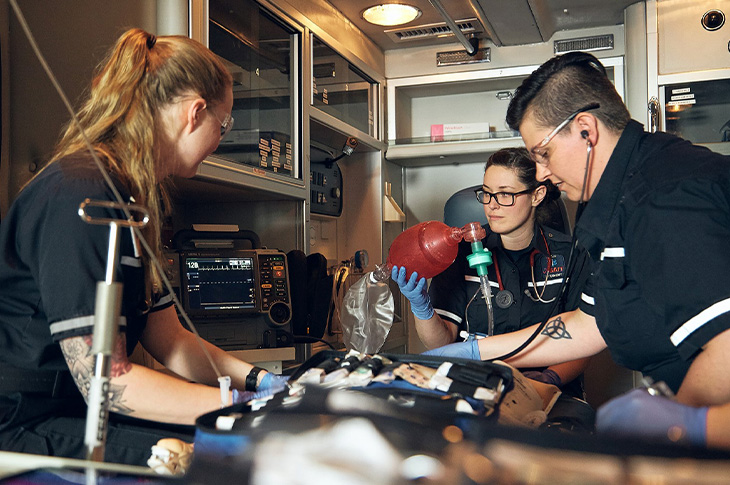Discover the updated Emergency Medical Responder program

According to the Government of Alberta, more than 500 ambulances and 5,500 Emergency Medical Service (EMS) practitioners answer the call of people in need each year in our province. That includes more than 550,000 emergency and transfer calls, on the ground and in the air, from cities to farms and everywhere in between. Taken simply as numbers, the statistics are staggering but these are not just numbers, these are people. And for each person facing a medical emergency, there needs to be a dedicated professional to help them through it.
The COVID-19 pandemic created new challenges for those answering the call as the pressure on the healthcare system continues to make headlines. The role of Emergency Medical Responders (EMR), Primary Care Paramedics (PCP) and Advanced Care Paramedics (ACP) has never been more critical. As we enter the second full year of this global pandemic, EMS practitioners continue to go about their work of supporting and caring for Albertans. The importance and value of EMS practitioners or the need for trained health professionals have never been more apparent.
To fill that need, the SAIT EMR Certificate of Achievement Program is evolving to meet the times by updating learning with science-backed changes in patient care. This includes a new focus on PPE or personal protective equipment — which, thanks to COVID-19 is an increasingly important part of the work, and enhanced attention to maintaining the mental and emotional health of every EMS practitioner. There's never been a better time to consider taking on a meaningful career that can make a difference in the lives of Albertans in need.
“It takes someone robust and adaptable to don full PPE on the side of the road at -40°,” says Daphne Stevenson, Advanced Care Paramedic and SAIT EMR instructor.
So, who are these PPE masked heroes and what kind of person does it take to join their ranks? Well, according to Stevenson, people who work in EMS are simply people who have a passion for helping others.
“It’s something ingrained and built in,” she explains.
While frontline work can be physically and mentally challenging, EMS practitioners make a difference every day, on every shift and in ways that may seem surprising. Yes, there are the lifesaving calls frontline workers must answer: strokes, heart attacks, and accidents, but more often, EMS practitioners are offering support to people at their most vulnerable times. It's moments like transporting a terminal patient to hospice and, if they ask, finding a quiet place to allow them to sit and feel the sunshine on their face one last time. Moments of responding to the frantic, terrified call of someone who has taken drugs for the first time and is on a hallucinogenic drug-induced trip. Each call comes with its own unique set of challenges, but the role of first responders is grounded in the importance of care and connection.
Ultimately, as Daphne Stevenson tells her students, “It’s not just about emergencies. EMS stands for Emergency Medical Service, but it is Emergency: rarely, Medical: sometimes, Service: always."
If you are considering transitioning to a fulfilling, exciting, service-oriented career where you can make a real difference in the lives you touch, or are looking to grow your knowledge and skills in health care, check out SAIT's EMR Certificate of Achievement Program. You may be able to begin answering the question once posed by renowned civil rights advocate Martin Luther King, “Life’s most persistent and urgent question is: What are you doing for others?” (King, Martin Luther, Jr., Oral speech, Montgomery, Alabama, 1957)
Start your journey towards a healthcare career with courses like:
- Foundations of Anatomy - Designed for students with no background in science to help develop an understanding of human anatomy.
- Reprocessing Audit Preparation - Help a medical or dental office prepare for general workplace medical device reprocessing audit, including best practices in equipment sterilization and disinfection.
- Bone Mineral Densitometry - Covers the fundamentals of bone density scanning.
If you’re working as a healthcare professional and interested in upgrading your knowledge, check out these courses approved by the Canadian Society for Medical Laboratory Science:
- Electrocardiography Theory Basic - Covers the knowledge and skills to perform 12 lead electrocardiographs.
- Specimen Accession Theory - Provides the skills and knowledge required to work in central specimen reception in a clinical laboratory.
- Phlebotomy Theory – This self-study module, introduces equipment and techniques commonly used to obtain blood specimens for analysis.